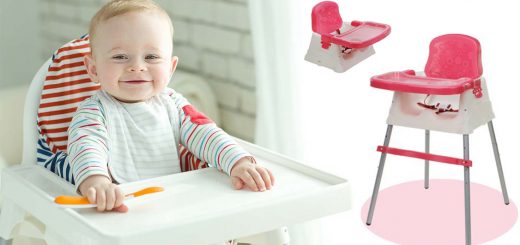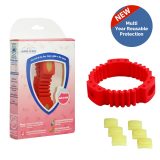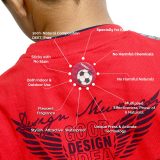WHAT TO DO WHEN YOUR KID IS NOT COMFORTABLE IN THE HIGH CHAIR
 One of the most difficult things to deal with when it comes to feeding babies is a kid who refuses to sit in its highchair! The last thing you want is your baby crying its heart out while sitting in its high chair at mealtimes. If your child screams seeing the highchair, spends the entire time in it attempting to get off and you’ve resorted to chasing your baby around with a spoon so you can slip in a mouthful of food at every appropriate moment, then you need to read ahead for some useful tips and tricks!
One of the most difficult things to deal with when it comes to feeding babies is a kid who refuses to sit in its highchair! The last thing you want is your baby crying its heart out while sitting in its high chair at mealtimes. If your child screams seeing the highchair, spends the entire time in it attempting to get off and you’ve resorted to chasing your baby around with a spoon so you can slip in a mouthful of food at every appropriate moment, then you need to read ahead for some useful tips and tricks!
Identifying the source of your baby’s discomfort while it is in the dining chair is one of the most effective ways to solve the problem of a baby refusing to sit in the highchair. Here are some plausible explanations for the baby’s aversion to the highchair, as well as some potential answers!
The kid could perhaps be uncomfortable
While this is less likely in older kids who can sit comfortably and appear to be at ease almost everywhere, it is possible in younger babies. If you start giving solids to your baby between the ages of 4 and 6 months, your child may not sit properly and will need extra help and if it does not get that, it will express the discomfort by crying. If you’re continually moving your baby in his highchair or the baby’s always slipping into an uncomfortable position, consider investing in (or using) a highchair designed for the comfort of younger babies as well.
It is likely that the kid is not hungry
It may seem self-evident, but when faced with a crying, unhappy baby, we tend to overlook the obvious! If you think you’re imposing a feeding schedule on your baby that the kid doesn’t like, learning to recognize the signs of whether the baby is actually hungry can help in calming down the little one. Babies are excellent at recognizing their own hunger and will not avoid food when they are really hungry, which is why you don’t need to push your baby to eat; this will turn mealtimes into a battleground, which neither of you will enjoy. While it may seem like the baby is crying due to discomfort in the dining chair, the truth may be entirely different.
The kid might be craving company
If you feed your kid at a different time than the rest of the family, the baby may perceive mealtimes as an activity that does not involve too many people. Many parents discover that if their kids are eating with the rest of the family, they will sit in the highchair much more willingly. Of course, it’s unlikely that your baby’s mealtimes will coincide with everyone else’s, but at the very least, prefer to sit with your kid and have a modest snack for them to have a feeling of company as they feed.
The kid could be in the midst of a clingy phase
If that’s the case, even the separation caused by a highchair may be too much for the baby to bear. Reassure your baby that you won’t abandon it. The baby needs assurance that you are sitting with it and interacting with the child as it enjoys its meal. When the baby is more used to dining in the highchair, you could discover that your kid sits there with finger foods while you carry out chores, having to keep only a watch on the little one.
The baby could simply be impatient!
If your little baby is screaming in the highchair and creating a ruckus, chances are that you’ve missed the right time and it is well past feeding time for the baby, it could simply be very hungry! The solution is to be ready and have the meal ready before placing your baby in the highchair. It works best if you have the food handy before your baby is set in the dining chair.
The kid could be bored
This is especially true for older babies who would rather be playing and crawling than remain strapped to a chair! So, with lots of praise and smiles, try to make mealtimes as enjoyable as possible. A decent highchair toy may prove to be useful. Also, don’t try to keep your child seated for an unreasonable amount of time so that they do not start feeling like they are held captive!
The kid might wish to assert their independence
If you’re currently spoon-feeding your infant, switch to finger foods! You might find that your kid enjoys feeding itself more, and as a result, your kid will be less likely to scream seeing the highchair.
The kid might not want to be treated like a baby anymore
And it can happen much sooner than you might imagine, as early as 12 months or so, especially if older siblings are around! Removing the highchair tray, lowering the seat, and pushing your child up to the table with the rest of the family may help. You may either utilize a booster seat with a standard dining chair or invest in a dining chair that converts to a low table and chair.
If Your Kid doesn’t Sit in the High Chair, DON’T
● let your kid eat while crawling or toddling around. This is not only a scary experience, but it’s also counterproductive, because the more you let your kid do it, the less likely it is that the kid will agree to sit in a highchair at mealtimes!
● feed your kid using other furniture as doing this will lead the baby to believe that food can be eaten wherever they like and that highchair discipline is not important.
Instead, condition the baby to believe that the highchair equals food (and so make it more appealing to your baby) by waiting until your baby is hungry before using it, feeding the little one ONLY in the highchair, and acknowledging it as a good habit, will work wonders to get your baby accustomed to the mealtime ritual.
‘What-to-Do’ Suggestions If Your Child has Developed an Aversion to the High Chair
For babies, mealtime is often a challenge and it doesn’t get any easier as they get older. However, if your baby has developed an aversion to the high chair, there are a few things you may do to encourage him to stay in it.
A Source of Distraction
Only younger babies benefit from distraction at eating. Sing your baby’s favourite rhymes or offer finger food to hold in the hand or lift your baby into an aeroplane stance with both hands and deceive the baby into landing on the high chair. Every mealtime, you can come up with something special that your baby will enjoy. It may take extra effort, but it will work most of the time.
Give them Toys to Play
For some kids, something as easy as providing them specific mealtime toys to play with will satisfy. Give them a variety of items; they don’t have to be toys. Something from the kitchen may also suffice.
Reduce the seat of the high chair or remove the tray.
When babies get older, they will become more aware of their environment and compare themselves to others, especially if they have siblings. They’ll want to sit at the dining table with their siblings or eat like adults. Reduce the height of the high chair to that of a dining chair, or remove the tray entirely so they can eat at the table as the others do.
Behavioral Training
It is critical to teach babies that a high chair is where mealtime takes place. Do not fall into the habit of feeding your baby in your lap or while they are running around the house, even if the baby despises the high chair. Instead, teach children that food is only consumed in the high chair. For a few days, they may throw tantrums, whine and cry, but they will gradually learn to stay in their high chair.
Do not force your baby to eat.
Parents have high expectations when it comes to feeding their kids, which leads to force-feeding. Force-feeding, on the other hand, can have a detrimental impact on their eating habits, and they may dislike sitting in the high chair and eating. Usually, one bad experience is all it takes for a baby to despise the high chair.
One of the most difficult things to do in the world is to manage a growing toddler. Taking the advice that resonates may lead you to breathe a sigh of relief as your baby gets into the habit of eating while remaining in the high chair. You can find the appropriate solution for your child if you understand the underlying problem that is causing their dislike for the dining chair.
Finally, in your journey to getting your child to eat healthy and stay happy, you need to make sure that you pick the most viable seller and the most reliable dining chair model for your little one’s mealtimes.















